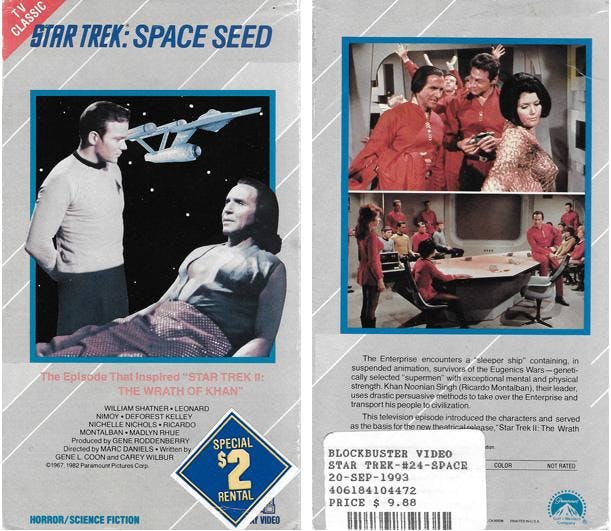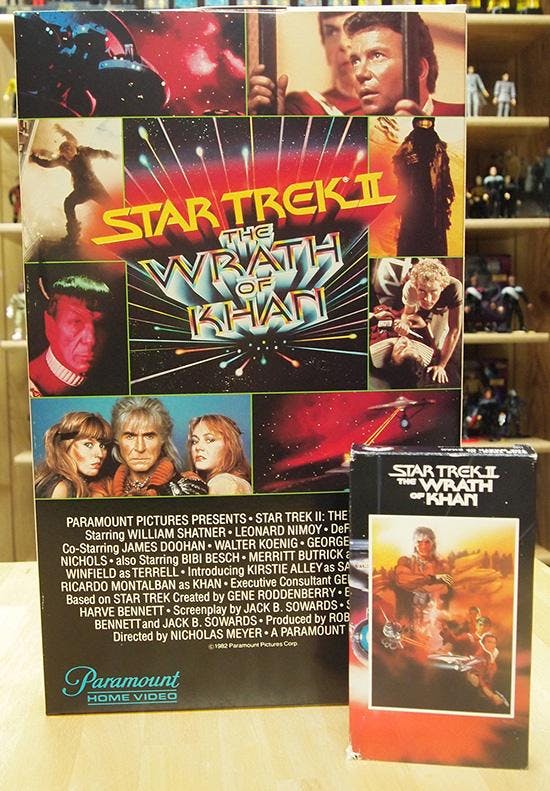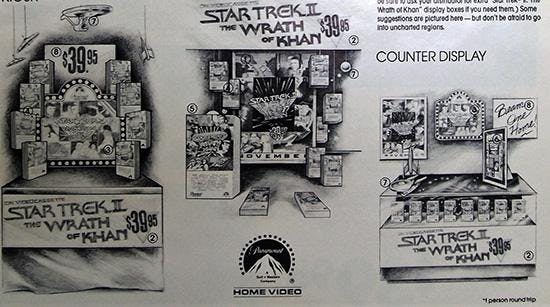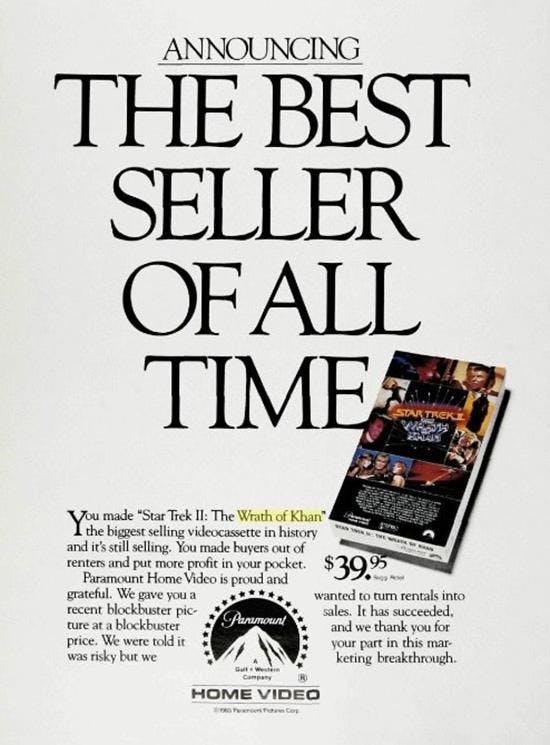Published Feb 1, 2018
'Space Seed,' Khan Forever Changed VHS Releases
"Space Seed," Khan Forever Changed VHS Releases

StarTrek.com
Now that Star Trek: Discovery has broken records in the entertainment frontier of streaming television, it seems appropriate to reflect on past examples in which Star Trek played an important role in popularizing new home entertainment options and technologies. One of the most significant example is how “Space Seed” and Star Trek II: The Wrath of Khan helped energize the home VHS library phenomenon.
During the late 1970s and early 1980s, VHS, Betamax, and CED players were becoming increasingly common. However, due to the cost of the actual tapes, most people could not afford to purchase their own copies, and thus rented films on VHS or Betamax. A single blank tape was $20 or more during the 1970s, and a tape with a film on it was usually $80 and up. To rent a film at a video store usually required a deposit commiserate with the cost a film, or at least the placement of a credit card on file, due to the high costs of the tapes. And many stores only allowed the rental of only one or two tapes at a time.
Paramount ran a unique experiment during the summer of 1982 in an effort to determine if there might be interest by consumers in purchasing films on VHS and Betamax -- to own. Such an experiment would require two things: offering TV shows or films directly to consumers that would be popular enough to entice people to buy them, and a lower price tag. Enter “Space Seed” and The Wrath of Khan.

Along with a select group of titles such as Raiders of the Lost Ark, Paramount’s home video production group, named Paramount Gateway, made “Space Seed” available during June 1982. STII had the biggest opening box office weekend in cinema history earlier that month, and “Space Seed” seemed an appropriate episode to test the interest in what would become known as the “sell through” market. When “Space Seed” was released on VHS that June, it earned the distinction of being the first Star Trek episode ever released on video tape designed specifically for home ownership market rather than rental. The question: would fans be willing to spend $29.95 for the Star Trek episode that inspired the popular STII playing that very moment at theaters?
The answer was a resounding yes.
A check of Billboard’s “Videocassette Top 40” shows that “Space Seed” stayed on the list of bestselling tapes nearly every week from the summer until the end of the year, and also into 1983, bolstered again by the release of STII on home video. Some versions of the tapes had a bonus STII trailer, while others did not.

Indeed, lightning struck again when STII was made available to the home market at $39.95, a savings of about $40 compared to the then-available Star Wars films and the previously available Star Trek: The Motion Picture. There was an extensive advertising campaign, complemented by a Paramount-sponsored retailer contest through which store owners assembled creative STII displays.

The most creative won a trip to Hollywood. By 1983, STII was the bestselling videocassette in history to that time. Expectations of 60,000 sales were more than doubled upon the counting of actual sales.

This success was important because Star Trek played an important role in popularizing the idea of home video libraries. “Space Seed” gave Paramount the confidence to eventually offer every TOS episode for purchase, a precursor to today's DVD, Blu-ray and streaming collections. Raiders of the Lost Ark and STII demonstrated that movie fans buy their favorite films to watch again and again whenever they wished – the beginnings of the on-demand experience common today.
Star Trek, as we all know, reshaped the entertainment, pop culture and science landscapes in many ways. And, as proven by “Space Seed” and STII, and later The Next Generation (with its success as a syndicated first-run drama), Star Trek also impacted how how Hollywood does business.
--
Maria Jose and John Tenuto are sociology professors at the College of Lake County in Grayslake, Illinois, specializing in pop culture and subculture studies. The Tenutos have conducted extensive research on Trek's history, and have presented at venues such as Creation conventions and St. Louis Science Center. They've written for the official Star Trek Magazine and their extensive collection of Trek items has been featured in SFX Magazine. Their theory about the “20-Year Nostalgia Cycle” and research on Trek fans has been featured on WGN News, BBC Radio, and in the documentary The Force Among Us. They recently researched all known paperwork from the making of the classic episode "Space Seed" and are excited to share some previously unreported information about Khan's first adventure with fellow fans. Contact the Tenutos at jtenuto@clcillinois.edu or mjtenuto@clcillinois.edu.

